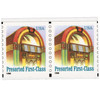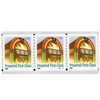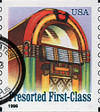
# 3132 - 1997 25c Juke Box, non-denominational, linerless coil
US #3132
1997 Juke Box (Linerless Coil) – American Culture Series
- One of the first US linerless coil stamps (the other being US #3133)
- Pictures the iconic Wurlitzer 1015 jukebox
- The fourth stamp with this design
- Part of the American Culture Series
Stamp Category: Definitive
Series: American Culture
Value: 25¢, Nondenominated Presorted First Class Mail Rate
First Day of Issue: January 24, 1997
First Day City: Tucson, Arizona
Quantity Issued: 200,064,000
Printed by: Bureau of Engraving and Printing
Printing Method: Photogravure
Format: Coils of 3,000 (Self-adhesive without liner paper)
Perforations: 9.8 (Die-cut simulated perforations – Goebel die cutter)
Tagging: Untagged
Why the stamp was issued: To cover the Presorted First Class Mail Rate.
About the stamp design: Same design as three previous Jukebox stamps (two coil stamps with water-activated gum issued March 17, 1995, and a self-adhesive coil stamp issued June 15, 1996). This stamp is self-adhesive and can be distinguished by the blue-green “1997” date below the left side of the design. The earlier stamps had “1995” and “1996” dates.
Special design details: Like the previous Jukebox stamps, the design was based on a colored pencil drawing by Bill Nelson of a Wurlitzer Model 1015 jukebox. This 1946 model is the most well-known and popular jukebox ever made.
First Day City: Issued at Aripex stamp show with no First Day Ceremony.
About the American Culture Series: This series shows images representing our nation’s popular culture. Art director Carl Herrman said, “The series tries to take a look at American creativity and at things that no other country could claim.”
Along with the American Scenes & American Transportation Series, the American Culture Series was created in 1995 as part of the USPS’s process of converting its service-inscribed stamps for discounted bulk mail to non-denominated postage stamps. Bulk mailers could buy the appropriate stamps at a fixed price, affix them to their mail, then pay the difference between the cost of the stamps and current postage when they mailed them out. This was done so that new stamps wouldn’t need to be created when rates changed.
History the stamp represents: Coin-operated music boxes and player pianos have been around since the 1890s. Over the years, technology improved and the first jukeboxes appeared in 1940. “Jukebox” came from the “juke joints” (named using the Gullah word juke meaning “bawdy”) common around that time. At first, many people rejected the term due to its associations with Black Americans, but, eventually, the name stuck.
Jukeboxes were extremely popular from the 1940s through the mid-1960s, but are most often associated with the 1950s. Perhaps the most famous and popular model was the 1946 Wurlitzer Model 1015 “bubbler.” It had the iconic colorful arch design and allowed listeners to choose from 24 different records. These were often the newest songs of the time, hastening the jukebox’s rise in popularity.
Eventually, portable radios appeared and jukeboxes began to fall in popularity. However, they can still be found in a few restaurants, bars, bowling alleys, and arcades today. In fact, their nostalgia and pop culture history have led collectors around the world to buy them and ensure their survival for generations to come.
US #3132
1997 Juke Box (Linerless Coil) – American Culture Series
- One of the first US linerless coil stamps (the other being US #3133)
- Pictures the iconic Wurlitzer 1015 jukebox
- The fourth stamp with this design
- Part of the American Culture Series
Stamp Category: Definitive
Series: American Culture
Value: 25¢, Nondenominated Presorted First Class Mail Rate
First Day of Issue: January 24, 1997
First Day City: Tucson, Arizona
Quantity Issued: 200,064,000
Printed by: Bureau of Engraving and Printing
Printing Method: Photogravure
Format: Coils of 3,000 (Self-adhesive without liner paper)
Perforations: 9.8 (Die-cut simulated perforations – Goebel die cutter)
Tagging: Untagged
Why the stamp was issued: To cover the Presorted First Class Mail Rate.
About the stamp design: Same design as three previous Jukebox stamps (two coil stamps with water-activated gum issued March 17, 1995, and a self-adhesive coil stamp issued June 15, 1996). This stamp is self-adhesive and can be distinguished by the blue-green “1997” date below the left side of the design. The earlier stamps had “1995” and “1996” dates.
Special design details: Like the previous Jukebox stamps, the design was based on a colored pencil drawing by Bill Nelson of a Wurlitzer Model 1015 jukebox. This 1946 model is the most well-known and popular jukebox ever made.
First Day City: Issued at Aripex stamp show with no First Day Ceremony.
About the American Culture Series: This series shows images representing our nation’s popular culture. Art director Carl Herrman said, “The series tries to take a look at American creativity and at things that no other country could claim.”
Along with the American Scenes & American Transportation Series, the American Culture Series was created in 1995 as part of the USPS’s process of converting its service-inscribed stamps for discounted bulk mail to non-denominated postage stamps. Bulk mailers could buy the appropriate stamps at a fixed price, affix them to their mail, then pay the difference between the cost of the stamps and current postage when they mailed them out. This was done so that new stamps wouldn’t need to be created when rates changed.
History the stamp represents: Coin-operated music boxes and player pianos have been around since the 1890s. Over the years, technology improved and the first jukeboxes appeared in 1940. “Jukebox” came from the “juke joints” (named using the Gullah word juke meaning “bawdy”) common around that time. At first, many people rejected the term due to its associations with Black Americans, but, eventually, the name stuck.
Jukeboxes were extremely popular from the 1940s through the mid-1960s, but are most often associated with the 1950s. Perhaps the most famous and popular model was the 1946 Wurlitzer Model 1015 “bubbler.” It had the iconic colorful arch design and allowed listeners to choose from 24 different records. These were often the newest songs of the time, hastening the jukebox’s rise in popularity.
Eventually, portable radios appeared and jukeboxes began to fall in popularity. However, they can still be found in a few restaurants, bars, bowling alleys, and arcades today. In fact, their nostalgia and pop culture history have led collectors around the world to buy them and ensure their survival for generations to come.





















